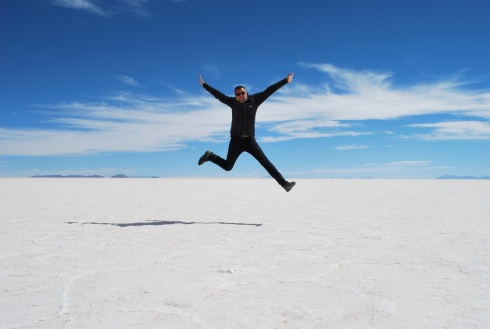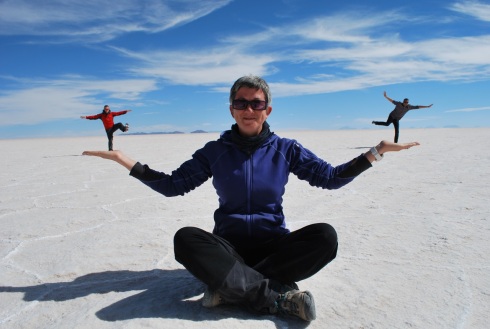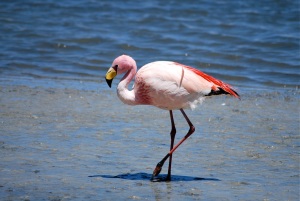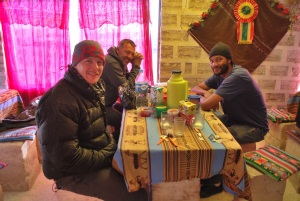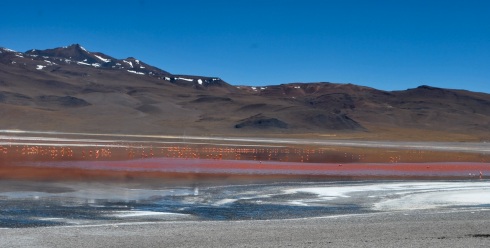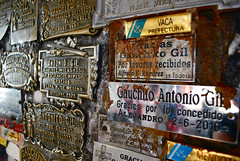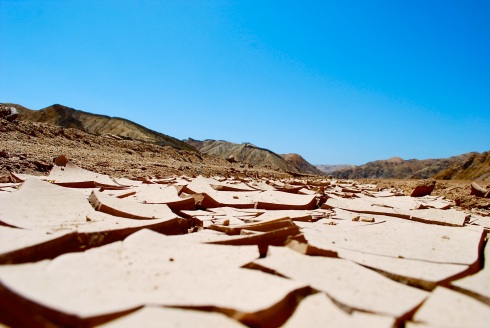
Er, bit dry here in the desert isn’t it? Pan de Azucar National park, Chile.
La Paz, Bolivia
by Paula
We’ve been over-doing things recently, in the best possible way. What with our marathon journey south to meet my family – the Jollys – in Chile, and the ensuing five weeks of astounding sightseeing, travelling and general Jollity, we’re all out of superlatives.
As well as that, there’s been a large overdose of sun, booze, food and spending. It’s been a blast, but the waistlines and wallets have taken a hit.
We’re about to get our wellies on and dig in for a cold, rainy winter in the Bolivian highlands – it’s the least we deserve; the austerity programme starts here.
So busy have we been that the blog has been badly neglected, so we’ll deal with all the amazing stuff we’ve been doing in a couple of posts. If you get bored at any point, you might want to play ‘superlative bingo’ – see how many times you can count us saying ‘fabulous’ ‘stunning’ ‘the best ever xx we’ve ever seen’, ‘unbelievable’, ‘breathtaking’ etc. You get the idea. The north of Chile and south of Bolivia have some of the most breathtaking (got it?) landscapes imaginable – no words (or even photos – see gallery below) truly come close to doing it justice.
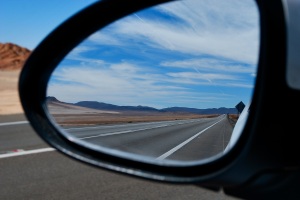
The long, straight, drive south through the Atacama Desert.
After racing through Peru last month, we picked up a rental car in northern Chile and started the two-day drive south to meet my parents in La Serena. Some people may find deserts boring, but we never tired of the seemingly endless straight roads cutting through the Atacama desert. For the first time on our trip we really had to think hard about refuelling the car and ourselves, as we could go for hours without seeing a sign of civilisation.
We’d booked a cabaña for the first week of my parents’ trip and would be mostly catering for ourselves. It was a major national holiday – celebrating independence from Spain – and we found out that every supermarket in the country would shut for 48 hours, just before my parents arrived. Panic stations! The idea of telling them, after their 30-hour journey from Scotland – ‘er, we haven’t got any food, or (even worse) wine‘ was unthinkable. We screeched into Copiapó a couple of hours before the final closing, to stock up. It was the equivalent of starting all your festive shopping at 4pm on Christmas Eve – ill-advised and ugly. Shelves were emptying, people were scrapping over the last mouldy onions and children howled as if Armageddon was coming. We threw together some meals we hoped wouldn’t go off in the hot car, and pushed on south.
The moment had arrived! We collected my parents at tiny La Serena airport and crushed their stuff into our far-too-small car, along with all the panic-bought wine, and drove to Vicuña, in the Elqui Valley. We spent a week in this stunning, rainless valley where pisco and wine grapes abound, as well as fruits and olives. It was all so lush compared with our drive south.
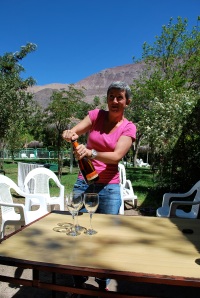
Happy birthday to me. Elqui Valley, Chile.
I enjoyed a birthday of post-breakfast champagne, followed by a scrumptious lunch of roasted goat at one of Elqui’s solar kitchens – where everything, from the bread to the meat and the mashed potatoes, is cooked in simple metal ovens that are fuelled purely by the heat of the sun.
It was shockingly cold in the mornings, until the sun warmed the valley, and in the evenings too, when we huddled into fleeces and went out to gaze at the most amazing stars we’d seen in years.
We were starting to form some first impressions of Chile – unbelieveable skies, fabulous empanadas and sandwiches, lovely straight un-potholed roads. And, most importantly, gallons of very quaffable wine plus a very healthy respect for a Proper Cup of Tea.
On the downside… terrible accents! We started to doubt that we could actually speak any Spanish at all, until one Chilean reassured us, ‘don’t worry, our Spanish is awful, no one can understand us.’ And prices that make you want to weep with despair (how much?!) – with one exception; wine at prices that bring tears of joy.
After a lovely week of mooching around Elqui, we pushed on north, stopping for a night of pisco sours and fish at Bahía Inglesa, and then on to the magical Pan de Azúcar National Park.
Now, in our experience so far, much of the north Chilean coast is not much to write home about – a lot of creepy half-abandoned coastal slum towns, heavy smoky industry and mining, and all often blanketed in a coastal fog.
“The idea of my dad bottling some Chilean partygoer, whilst still in his underwear, gave me cause to ponder…”
But there are exceptions, and one of those is Pan de Azúcar – a sparklingly pristine piece of coastal desert, with a little island that’s home to a few thousand Humboldt penguins. We pitched up at a cabaña and camping place, with a smack-bang view of the island, and slept like babies to the sound of the waves. On our first morning we could see the penguins pottering about on the beach through the binoculars. Beyond excited! For a closer look we took a boat out to the island and got to watch them from close to shore, also seeing sea otters, sea lions and spectacularly colourful pelicans. Fabulous.
One of the many reasons we’d chosen this spot was for the peace and quiet. With it also being a national park, there were rules about not making noise, playing music, partying and so on. Safe bet, we thought.
On the afternoon of our second night, the Chilean Hillbillies arrived – a massive family in the cabaña next to mum and dad’s. We eyed them a little suspiciously. It was Saturday night, what did they have planned? That might sound a bit paranoid, but anyone who’s read our blog before – or any account of travelling in Latin America – will know that our fears were justified. How can I put this? – very generally speaking, there is a widespread lack of consideration for other people’s tranquility here. So much so that people planning a beach party will often park right next to where you’re camped, despite there being 10 miles of empty beach for them to choose from.
And so it was this time – music blaring from their open car, shouting at the tops of voices for hours on end, despite polite pleas to turn the music down. About 10 of them were outside their cabaña and about 3ft from our tent, all night.
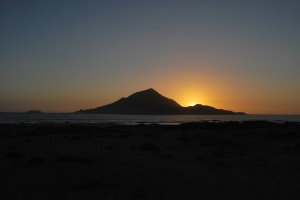
Sunset view from our cabana at Pan de Azucar national park – looks peaceful, eh?
I’m pretty resigned to putting up with this sort of thing when it’s just Jeremy and I, but when the family are having their night ruined, I see red.
At 4am I cracked. I went over to ask them to go inside their cabaña, so we couldn’t hear their noise so much. They refused. They said: ‘We have babies inside the cabin, if we go inside our noise will wake them.’ I was incredulous. I said that they were doing just the same to my parents instead.
‘Do you think your parents are more important than our children?‘ they asked? I said they were equal. They laughed as if this was the most preposterous idea they’d ever heard. By this time there was a lot of shouting. They told Jeremy: ‘Chileans party til 5am, get over it!‘
Unbeknown to me, by this point my dad was poised at their cabaña door with a blunt weapon, ready to smack someone if it got out of hand. (note: he has no actual history of violence).
The idea of my dad bottling some Chilean partygoer, whilst still in his underwear, gave me cause to ponder: ‘Hhmmm, must do better next time on planning relaxing holiday for the parents…’
But it was a mere blip. We blew away the sleepy cobwebs the next day with a spectacular walk up on the plains, with giant cacti and dramatic cloud formations punctuating the bright yellow landscape and azure skies, then came home to snuggle in with a chicken soup.
It was a pretty wild place. In the evenings we retreated into the cabaña at sunset and, even when inside, piled coats and blankets on, playing cards and keeping warm with wine and pisco. Mum and dad took the ‘roughing it’ pretty well!
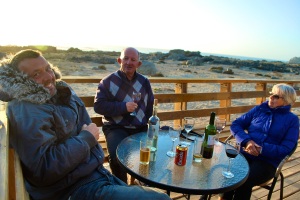
All wrapped up for a chilly Chilean evening, Pan de Azucar national park.
After navigating the busy one-way streets of Antofagasta, with only a little shouting involved, we spent the night there before moving on to our final destination for mum and dad – a week in the heart of the desert, in San Pedro de Atacama.
Only a little more shouting was involved in our trying to find our cabaña, in a dusty little plot on the edge of town. It was a sweet adobe place with a magnificent view of the mountains, the most awesome of which was the almost 6,000-ft Volcano Licancabur. Its snow-capped peak shone by day and turned luminous pink by sunset. It’s hard to describe what it’s like being in one of the driest places on earth. We’ve never felt so desiccated, and no amount of water or moisturiser seemed to hit the spot.
We spent a fabulous day driving round some of the nearby sights, including a walk and picnic at the breathtaking oasis of Quebrada de Jerez – one of those lovely desert surprises that you wish you’d been the first to stumble upon.
At Laguna Chaxa – in the middle of the Atacama salt flats – we got our first sight of flamingos amid a spectacular mountain and lake setting, and watched them for hours.
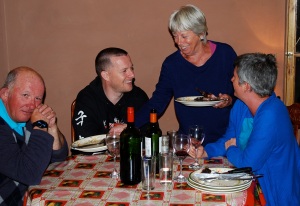
Derek arrives! San Pedro de Atacama, Chile.
Next day, it was back to Calama to collect my brother Derek from the airport! We celebrated with a barbeque and – you’ve probably guessed it – a vat of Chilean wine. Coincidentally it was our second anniversary of being on the road in Latin America.
Next day we became the only people on the planet to fail to find one of the most famous sights around San Pedro – the Valley of the Moon. ‘It must be here somewhere‘, I kept confidently declaring, as we drove further and further across the salar, before realising we’d missed the turning and also missed sunset. Oh well!
A star tour with an astrologist in San Pedro was one of the highlights of the few weeks. We gathered in the dark and looked up at the biggest sky imaginable. Venus shone under a sliver of a moon. We tried our best to absorb a dizzying and humbling barrage of space facts, before gazing through mega-telescopes at the most incredible sights we’ve ever witnessed, including a supernova, distant galaxies and disco-lights stars. (not the technical term, I don’t think).
One constellation was so impressively sparkly that everyone gasped when they saw it. ‘Yeah, we call that one the eyegasm‘ said the astrologer.
After a hot hike to the indigenous Atacameño ruins at Pukará de Quitor the following day, we set off for a second attempt to enjoy sunset at the Valley of the Moon. You won’t be surprised to hear it’s a bit like a moonscape. Sitting on a vast sand dune and watching the colours change over the jagged rocks and distant mountains at sunset was pretty other-worldly.
It was tears and gloom as my parents set off for home the next day. One of the absolute worst things about being away from home are those awful airport goodbyes.
Derek, Jeremy and I bedded down in Calama for a few hours, before starting the next phase of the Jolly holiday early the next morning.
We thought we were all out of superlatives to describe everything we’d been seeing…. and then we got to Bolivia…
Days: 754
Van miles: 17,551 (to Ecuador – where the van remains for now)
Non-van miles!: 7,239
Things we now know to be true: Outer space is really, really big.
—-
PICS PICS PICS!
Below is a pic gallery of some of the recent highlights – just a handful of the 2,000+ images taken over this period….

Train passing through the Atacama Desert, Chile.

Celebrations for Fiestas Patrias – independence from Spain, La Serena, Chile.

The stunning Elqui Valley, Chile.

Solar ovens, near Vicuna, Elqui Valley, Chile

Pisco sour, Bahia Inglesa, Chile.

Pan amasado – a typical Chilean bread – for sale, Atacama Desert.

Breakfast stop-off at brightly-painted Taltal, Chile.

Abandoned nitrate town, Atacama Desert, Chile

All ready for a trip to see the penguins! Pan de Azucar national park, Chile.

Penguin! Isla Pan de Azucar, Chile.

Sea lion stretches, Pan de Azucar, Chile.

BBQ time, Pan de Azucar, Chile.

Me and mum, desert walk, Pan de Azucar, Chile.

Amazing skies, Pan de Azucar, Chile

Our cabana at Pan de Azucar national park, Chile.

Chatting at Pan de Azucar national park, Chile.

Desert fox, Pan de Azucar National Park, Chile.

What a catch! Fisherman shows off his haul, Pan de Azucar national park, Chile.

Pan de Azucar sunset, Chile.

The impossibly yellow trees outside our San Pedro cabana, Atacama, Chile.

Desert oasis at Quebrada de Jerez, Atacama, Chile.

Salar de Atacama, Chile.

Oasis at Quebrada de Jerez, Atacama, Chile.

Flamingo, Laguna Chaxa, Salar de Atacama, Chile.

Laguna Chaxa, Salar de Atacama, Chile

Flamingo takes flight, Laguna Chaxa, Salar de Atacama, Chile.

Walking on salt, Laguna Chaxa, Salar de Atacama, Chile.

Laguna Chaxa, Salar de Atacama, Chile

The Dears, Atacama, Chile.

Valley of Death, Atacama, Chile.

Jeremy ponders the Valley of Death, Atacama, Chile.

Three Jollys, a Dear and a Jolly Dear – Pukará de Quitor, Atacama, Chile

The view of Volcan Licancabur from our cabana in San Pedro de Atacama, Chile.

Stop-off on the drive through the Valley of the Moon, Atacama, Chile.

Sand dune, Valley of the Moon, Atacama, Chile

Three amigos – Derek, Paula and Jeremy – Atacama, Chile.

Natural amphitheatre, Valley of the Moon, Atacama, Chile.

Sand dune, Valley of the Moon, Atacama, Chile

Sunset, Valley of the Moon, Atacama, Chile.

Sunset, Valley of the Moon, Atacama, Chile.
Tags: Atacama, bahia inglesa, Bolivia, Calama, camping, Chile, desert, Elqui Valley, flamingos, Humboldt penguins, Jeremy and Paula Dear, La Serena, Laguna Chaxar, Pan de Azucar, Paula and Jeremy Dear, pelican, Pukará de Quitor, Quebrada de Jerez, salar de Atacama, San Pedro de Atacama, sea lion, sea otter, seventeenbysix, solar kitchen, stars, Valle de Luna, Valley of the Moon, Vicuna, VW, VW Eurovan

